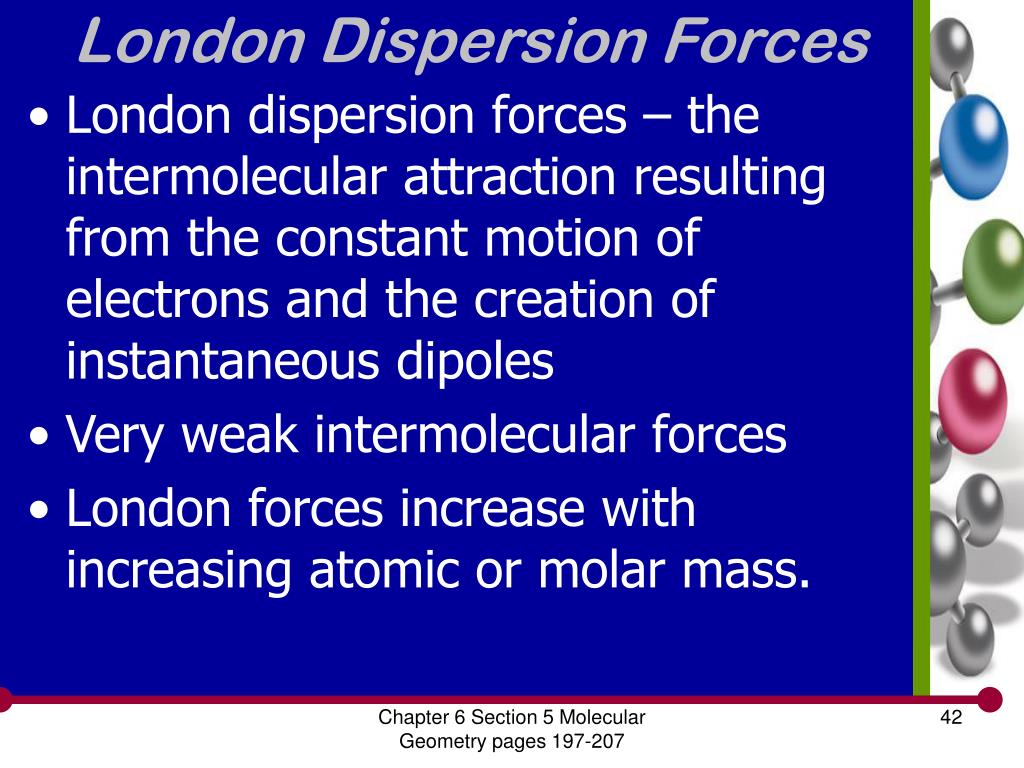

The magnitude of the London dispersion force is frequently described in terms of a single parameter called the Hamaker constant, typically symbolized A. While the detailed theory requires a quantum-mechanical explanation (see quantum mechanical theory of dispersion forces), the effect is frequently described as the formation of the instantaneous dipoles that (when separated by vacuum) attract each other. The net effect is that the fluctuations in electron positions in one atom induce a corresponding redistribution of electrons in other atoms, such that the electron motions become correlated. These fluctuations create instantaneous electric fields which are felt by other nearby atoms and molecules, which in turn adjust the spatial distribution of their own electrons. Therefore dispersion forces and dipole-dipole forces act between pairs of HCN molecules.The electron distribution around an atom or molecule undergoes fluctuations in time. (d) HCN is a linear molecule it does have a permanent dipole moment it does contain N, however the nitrogen is not directly bonded to a hydrogen. In PCl3, there are also dipole-dipole forces and dipole-induced dipole forces. As such, the only intermolecular forces active in PCl5 are induced dipole-induced dipole forces (London dispersion forces). (a) PCl3 is polar while PCl5 is nonpolar. If the molecules have no dipole moment, (e.g., H2, noble gases etc.) then the only interaction between them will be the weak London dispersion (induced dipole) force. Its strongest intermolecular forces are London dispersion forces. Does CCl4 have London dispersion forces?ĬCl4 is a nonpolar molecule. Does I2 have London dispersion forces?ģ) F2, Cl2, Br2 and I2 are non-polar molecules, therefore they have London dispersion forces between molecules. … HF is a polar molecule so both dispersion forces and dipole-dipole forces are present. So London dispersion forces are the result of instantaneous dipoles that briefly form in nonpolar atoms or molecules. How do you identify dipole dipole forces?

Dipole-dipole forces are between polar molecules, and since polar molecules have slight charges, their force is more similar to ions, giving them a moderately strong bond. What is the difference between London dispersion forces and dipole-dipole forces?Įxplanation: London dispersion forces occur between nonpolar molecules and are extremely weak. … The force gets its name because Fritz London first explained how noble gas atoms could be attracted to each other in 1930. London dispersion force is a weak intermolecular force between two atoms or molecules in close proximity to each other. Why London forces are called dispersion forces? To describe the intermolecular forces in liquids. What are the 4 types of intermolecular forces?ġ2.6: Types of Intermolecular Forces- Dispersion, Dipole–Dipole, Hydrogen Bonding, and Ion-Dipole. Physical State at Room Temperature The dispersion forces are strongest for iodine molecules because they have the greatest number of electrons. Which molecule has the largest London dispersion forces?

Yes, it is true, hydrogen bonding (N-H bonds makes between molecules) and dipole dipole interaction (interaction between two dipole) and london dispersion forces occur between nh3 molecules. H2O exhibits the relatively strong hydrogen-bonding interactions. Is CO2 a London dispersion force?ĬO2 is nonpolar and only exhibits London dispersion forces. Therefore, the only intermolecular forces are London dispersion forces. Thus, although CO₂ has polar bonds, it is a nonpolar molecule. The dipoles point in opposite directions, so they cancel each other out. Is co dispersion only?ĬO has two C-O bonds. that why ch4 has not permanent dipoles dipole interaction. there is not a big difference of Electronegativity between C and H. Is ch4 London dispersion?Ĭh4 has only London dispersion forces. That is why helium has such a low boiling point of -452° F. This force is very weak, so it doesn’t hold those molecules together very strongly. The only intermolecular force it has between molecules is a London dispersion force. Does he have London dispersion forces?įor instance, helium, He, is a noble gas. What factors affect London dispersion forces?įactors that affects the strength of a dispersion force include : Distance between molecules, polarizability and the shape of the molecule.


 0 kommentar(er)
0 kommentar(er)
